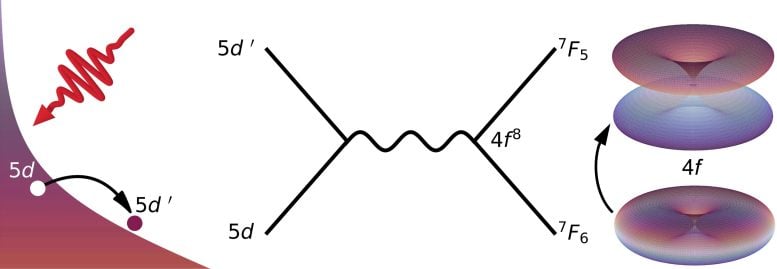
Laser pulses have been shown to adjust the magnetic properties of rare earths by affecting 4f electrons, opening avenues for quicker and more energy-efficient data storage devices.
The special properties of rare earth magnetic materials are due to the electrons in the 4f shell. Until now, the magnetic properties of 4f electrons were considered almost impossible to control. Now, scientists have shown for the first time that laser pulses can influence 4f electrons — and thus change their magnetic properties. The discovery, which was made through experiments at EuXFEL and FLASH, opens up a new way to data storage with rare earth elements.
Breakthrough in Magnetic Properties Control
The strongest magnets we know of are based on rare earths. Their 4f electrons are responsible for their magnetic properties: they generate a large magnetic moment that is maintained even when their chemical environment changes. This means that rare earths can be used in very different compounds and alloys without changing their special magnetic properties.
Until now, it was assumed that the magnetic properties of 4f electrons could not be changed even if the material was excited with a laser pulse. But indeed, this is possible, as a team from the Helmholtz Center for Materials and Energy (HZB), Freie Universität Berlin, DESY, the European X-ray laser XFEL, and other institutions has now shown that the spatial arrangement of the 4f electrons can be briefly switched by laser excitation. This also changes their magnetism.
This effect opens up new possibilities for the fast and energy-efficient control of magnetic rare-earth materials. The work will be published today (August 5) in the journal Science Advances.

Experimental Insights From X-ray Lasers
The team carried out experiments with the X-ray lasers EuXFEL and FLASH and analyzed samples of terbium, a rare earth element with atomic number 65 and a total of 8 electrons in 4f orbitals. The sample was excited with an ultrashort laser pulse and analyzed by X-ray spectroscopy. The soft X-ray radiation used in the study is able to determine the electronic structure of a material very sensitively.
The experiment shows that after laser excitation, 4f electrons briefly switch to an orbital with a different spatial distribution. This is due to a scattering process with 5d electrons, which had not been considered before. The redistribution of the 4f electrons by the laser excitation causes a brief switch in their magnetic properties.
Potential in Data Storage Technologies
This controlled switching opens up new applications for rare earth materials, such as energy-efficient and fast information storage devices. Until now, rare earths have not been used in magnetic storage media.
The latest storage media are so-called HAMR (Heat-Assisted Magnetic Recording) data storage devices, in which magnetic structures are heated by a laser pulse in order to be switched by a magnet. With the much stronger rare-earth magnets, an ultrashort laser pulse could now excite the 4f electrons and enable switching — an electronic effect that would be even faster and more efficient than the heating mechanism in HAMR memory.
Advancements in X-Ray Spectroscopy
This research has been made possible by the development of accelerator-based X-ray sources for generating ultrashort X-ray pulses in recent decades. These X-ray sources allow to observe elementary processes in magnetic materials on time scales of a few femtoseconds. A femtosecond (10-15 s) is one-millionth of a billionth of a second. Light travels by about a hair’s breadth in 300 femtoseconds.
The work was carried out at the European X-ray laser EuXFEL and at FLASH in Hamburg. The HZB also operates a short-pulse X-ray source, which will be expanded by the end of this year specifically for experiments with high spectroscopic resolution. BESSY II will then also offer optimal conditions for this type of experiment. Berlin is one of the world’s leading centers for research into ultrafast magnetic effects.
Reference: “Optical control of 4f orbital state in rare-earth metals” by Nele Thielemann-Kühn, Tim Amrhein, Wibke Bronsch, Somnath Jana, Niko Pontius, Robin Y. Engel, Piter S. Miedema, Dominik Legut, Karel Carva, Unai Atxitia, Benjamin E. van Kuiken, Martin Teichmann, Robert E. Carley, Laurent Mercadier, Alexander Yaroslavtsev, Giuseppe Mercurio, Loïc Le Guyader, Naman Agarwal, Rafael Gort, Andres Scherz, Siarhei Dziarzhytski, Günter Brenner, Federico Pressacco, Ru-Pan Wang, Jan O. Schunck, Mangalika Sinha, Martin Beye, Gheorghe S. Chiuzbăian, Peter M. Oppeneer, Martin Weinelt and Christian Schüßler-Langeheine, 17 April 2024, Science Advances.
DOI: 10.1126/sciadv.adk9522
The work at Freie Universität, Technische Universität, HZB, Fritz-Haber-Institut and Max-Born-Institut together with partners in Halle is funded by the German Research Foundation as part of a Transregional Collaborative Research Centre (Transregio-SFB 227 “Ultrafast Spin Dynamics”).
1 Comment
A new study reveals that laser pulses can change the magnetic properties of rare earth materials by influencing their 4f electrons. This capability, demonstrated in experiments with terbium at major X-ray facilities, could lead to faster, more efficient data storage solutions.
VERY GOOD!
The physical world is interactive and interconnected. There are various methods and forms of laser manipulation of electrons, including types, intensities, angles, and so on. The natural essence of material motion is the interaction and balance of topological vortex gravitational fields. The rotation of topological vortices is spin. Spin creates all things. Spin creates the world.
Spin is crucial in the evolution of spacetime motion of cosmic matter. Topological vortices are point defects in spacetime. Their rotation is spin. Their interaction is very interesting. Their superposition includes both logical superposition in space-time and factual superposition in reality. Their entanglement includes both surface entanglement and body entanglement. Their deflection methods are endless. In the interaction and balance of topological vortex fractal structures, spin creates everything (including gravity) in the world.
The universe does not make algebra, formulas, or fractions. The universe is a superposition, deflection, and entanglement of geometric shapes, is the interaction and balance of countless topological vortex fractal structures. In these interaction and balance, the past is difficult to change. For the future, some predictable, some unpredictable. But, the present moment is real, certain, and actionable. Physics should not ignore that low dimensional topological fractal structures are the material basis of high-dimensional spacetime.
Scientific research guided by correct theories can help humanity avoid detours, failures, and pomposity. Please witness the exemplary collaboration between theoretical physicists and experimentalists (https://scitechdaily.com/microscope-spacecrafts-most-precise-test-of-key-component-of-the-theory-of-general-relativity/#comment-854286). Some people in contemporary physics has always lived in a self righteous children’s story world. Whose values have been overturned by such a comical and ridiculous reality?
Misguided by the pseudo-scientific theory of Physical Review Letters (PRL), many researchers do not consider the similarities and differences between geometric shapes and physical reality in physics research, but indulge in imagination, and some scholars’ physics research seriously deviates from science, and they are almost unaware of the dirtiness and ugliness. Although mathematics is the language of science, it must be understood correctly.
I hope researchers are not fooled by the pseudoscientific theories of the Physical Review Letters (PRL), and hope more people dare to stand up and fight against rampant pseudoscience.
The so-called academic journals (such as Physical Review Letters, Nature, Science, etc.) firmly believe that two high-dimensional spacetime objects (such as two sets of cobalt-60) rotating in opposite directions can be transformed into two objects that mirror each other, is a typical case of pseudoscience rampant.
Scientific research should be respected, but some people in contemporary physics are not. Please witness the actions of certain individuals and publications. If researchers are really interested in Science and Physics, you can browse https://zhuanlan.zhihu.com/p/643404671 and https://zhuanlan.zhihu.com/p/595280873.
The Physical Review journals, encompassing both hybrid and open-access journals, features 17 peer-reviewed publications including Physical Review Letters, Physical Review X, and Reviews of Modern Physics. CP violation was published in Physics Review in 1956. All peer-reviewed publications of Physical Review family are responsible for clarifying this. CP violation opened the dirtiest and ugliest era in the history of physics.